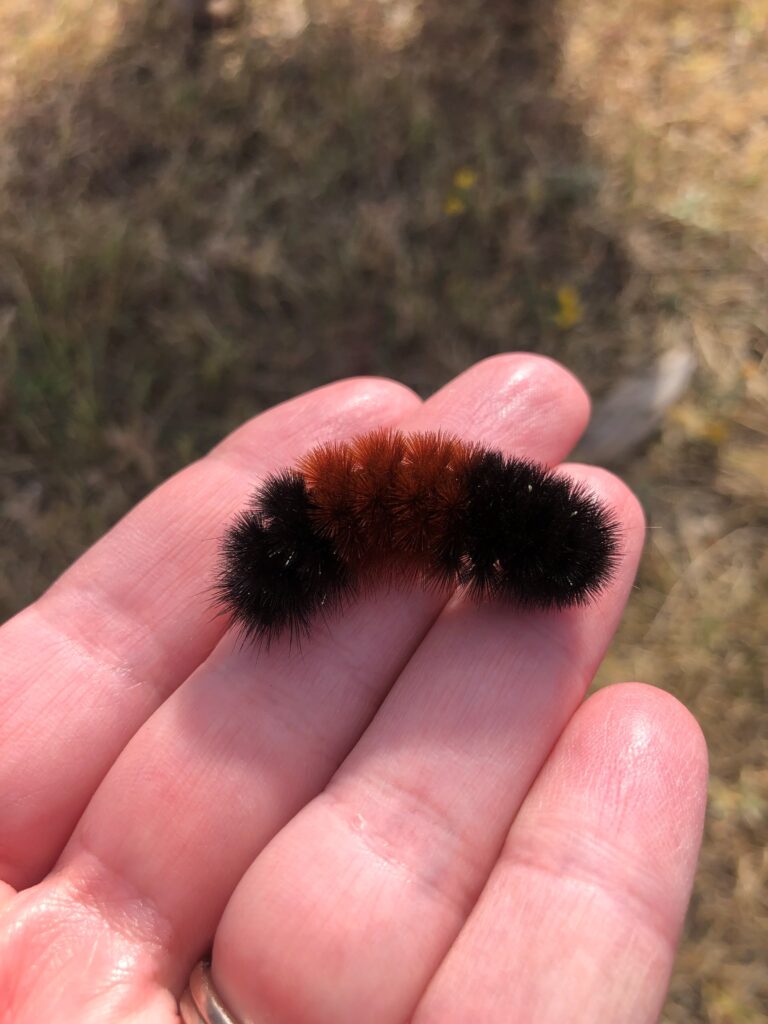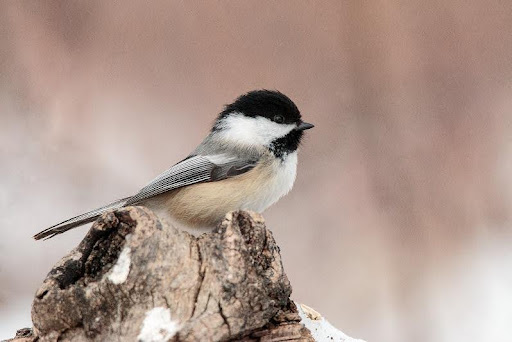From the Hort Desk
- 2024-11-08
- By mkirk
- Posted in Horticulture, The Garden Buzz
Supporting Overwintering Pollinators, Beneficial Insects and Birds
By Lisa Mason, CSU Extension Horticulture Specialist, Entomologist
Does “leaving the leaves” support the overwintering insects?
Leaf litter supports hibernating queen bumble bees by providing them a sheltered area for the winter. Solitary bees are well-protected in their underground or cavity nest, but leaf litter may provide some insulation for their ground nest. Since honeybees live in hives, they don’t rely on leaf litter but they have been observed drinking water from damp leaf piles. Leaf litter also supports a wide diversity of arthropods by providing shelter during the winter. Lacewings, an important predator of pest insects, overwinter in leaf and debris piles.

Wooly bear caterpillars are a great example of a moth that relies on leaf litter. They overwinter in the caterpillar stage by hibernating in leaf litter. They have impressive adaptations to survive the winter. When summer arrives, they complete metamorphosis and transform to an adult Isabella tiger moth. Mourning cloak butterflies overwinter as adults and seek a protected area to shelter for the winter. They are among the earliest butterflies to emerge in the spring. Overall, leaf litter can provide a shelter for a diversity of overwinter arthropods. Leaf litter is also a great mulch for perennial and vegetable gardens. The leaves also return critical nutrients back to the soil. While leaf litter is a valuable component to the landscape, it is important to remove leaves from the lawn to prevent mold and disease growth, and to avoid smothering the turf.
When should spring garden clean-up begin to best support the overwintering bees?
Different bee species emerge at different times, so it is a challenge to find a perfect date for spring garden clean-up that supports bees. Here are some general considerations for supporting overwinter bees:
- Bumble bee queens typically emerge from hibernation between mid-April and mid-May, depending on weather and elevation. Bumble bees could be impacted if leaf litter is disturbed before they emerge.
- Some solitary bees nest in hollow or pithy stems such as Rubus spp. (raspberries, blackberries, etc.), joe-pye weed, bee balm, etc. They will emerge in the spring. If hollow stems appear to be plugged, perhaps consider leaving the stems until they emerge, or stems could be carefully moved to a protected location where they won’t be disturbed.
- Leafcutter bees are often some of the latest emerging bees. They nest in a wide variety of cavity locations from natural spaces to human infrastructures (e.g. patio stones, a dead log, a bee hotel). Since they emerge later in the season, it is likely best to postpone garden work for leafcutter bees unless specific locations of nests are known that could be protected.
- Squash bees may nest in underground areas where squash and pumpkin plants are typically planted. Consider not tilling the vegetable garden to support these important pollinators.

What other winter activities can support pollinators, beneficial insects and birds?
- Consider adding plants next spring that support a biodiverse ecosystem in your landscape:
- Early season flowers offer pollen and nectar for early season native bees and honeybees. Some options include golden currant, chokecherry, crocus, and pasque flowers. Chokecherry is an excellent addition because it is a native host plant for the two-tailed swallowtail butterflies, the flowers feed pollinators, and the berries feed many bird species.
- Native, ornamental bunch grasses are host plants for a variety of butterflies. These grasses add winter interest to the landscape and provide habitat nesting spaces for a variety of beneficial insects. Some examples include blue grama, side oats grama, big bluestem, and little bluestem.
- Drought-tolerant shrubs can add varying heights to the vegetation in your landscape. This is beneficial for overall wildlife habitat and can provide shelter for birds, butterflies, and hummingbirds. Many shrubs produce flowers for beneficial insects and/or berries. Examples include fringed sage, fernbush, rabbitbrush, Apache plume and sand cherry.
- Trees can add additional habitat spaces. Conifer trees offer nesting and sheltering areas. Some deciduous trees can serve as host plants for caterpillars. Maple trees are one of the primary pollen sources for honeybees in the early spring. Fruit trees and catalpa trees can all offer pollen and nectar sources for pollinators. Keep in mind, linden trees are pollinator magnets, but they also attract Japanese beetles.
- With all plants, consider the right plant for the right place. Look at the mature size of the plant to ensure it has enough space.
- Remember that nectar-producing flowers that attract insects will also support bird populations. Small insects are a large portion of many birds’ diets, and they can’t rear young without the protein from insects.
- Don’t forget to water your trees and plants during the winter or any time of the year when we have warm, dry temperatures. Healthier plants can better support beneficial insects and birds by providing more nectar and pollen, more berries, and potentially more sheltered spaces for habitat.
- Leave the dandelions? It depends. When nectar and pollen sources are scarce, some species of native bees and honeybees will forage on dandelions. When there is little else available, it’s better than nothing. However, research has shown that the nutritional content is less valuable than other early-blooming plants. An alternative solution would be to plant additional pollinator-friendly plants in the landscape. This concept is important for other weed species, as well. Pollinators readily visit weeds like thistles, bindweed, etc. Consider adding pollinator-friendly plants to your weed management plan.
- Add a bird feeder and a birdbath to support the birds over the winter. There are a variety of birdbath heaters that will keep the water from freezing so the birds have access all winter long. Be sure to change out the water frequently. Bird seed can help support a bird’s diet throughout the winter. Check with your local bird store for seed recommendations for winter birds. Finches, chickadees, sparrows, jays, flickers, woodpeckers, spotted towhees, nuthatches, and robins are all commonly seen along the Front Range in the winter.

For more information, visit the online publication section of the CSU Extension website, or reach out to the Arapahoe County Extension office.
Horticulture Resources
- Garden Buzz Archives
- CSU Extension Resources
- Colorado Master Gardener Program
- Foothills to Plains Native Plant Master Program
- Native Bee Watch Community Science Program
- The Co-Hort Blog
- PlantTalk Colorado
- Soil Testing
- Plant Select
- Emerald Ash Borer
- Japanese Beetle
- Colorado State Forest Service
- Ask an Expert


